|
|
|
Sort Order |
|
|
|
Items / Page
|
|
|
|
|
|
|
| Srl | Item |
| 1 |
ID:
178207
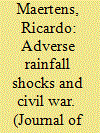

|
|
|
|
|
| Summary/Abstract |
News reports and policymakers frequently link African civil conflicts and wars to agricultural crises caused by droughts. However, empirical studies of the relationship between rainfall and civil conflict or war remain inconclusive. I reexamine this relationship focusing on rainfall over each country’s agricultural land during the growing seasons. I also incorporate that the relationship between rainfall and agricultural output is hump-shaped, as rainfall beyond a threshold decreases output. I find a U-shaped relationship between rainfall and the risk of civil conflict and war in (Sub-Saharan) African countries. This relationship mirrors the hump-shaped relationship between rainfall and agricultural output.
|
|
|
|
|
|
|
|
|
|
|
|
|
|
|
|
| 2 |
ID:
156954
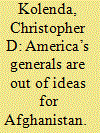

|
|
|
|
|
| Summary/Abstract |
President Donald Trump’s much-anticipated 21 August speech promised to roll out a new strategy for America’s 16-year-old war in Afghanistan. (Afghans themselves have been at war for nearly 40 years.) Those hoping for meaningful change were disappointed. The decision to do more of the same and expect different results underscores a broader strategic bankruptcy within the US national-security establishment that is eroding trust in American leadership.
|
|
|
|
|
|
|
|
|
|
|
|
|
|
|
|
| 3 |
ID:
130871
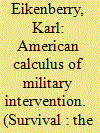

|
|
|
|
|
| Publication |
2014.
|
| Summary/Abstract |
The protracted campaigns in Afghanistan and Iraq have diminished America's appetite for waging wars to end tyranny or internal disorder in foreign lands. Military interventions have traditionally been a source of controversy in the United States. But America's appetite for the dispatch of armed forces has been diminished greatly by factors that have primarily emerged in the twenty-first century. These include, most painfully, the protracted campaigns in Afghanistan and Iraq that have made US political and military leaders more cautious about waging wars to end tyranny or internal disorder in foreign lands.
|
|
|
|
|
|
|
|
|
|
|
|
|
|
|
|
| 4 |
ID:
159898
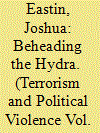

|
|
|
|
|
| Summary/Abstract |
We evaluate the effectiveness of anti-insurgent violence as a means to suppress insurgency with micro-level data from the Iraq War. Our findings suggest that while violence against insurgents increases the incidence of future insurgent attacks, the intensity of this violence can significantly influence the outcome. Rather than shifting monotonically, the effect is actually curvilinear, first rising, and then contracting. We argue that at low to moderate levels, violence against insurgents creates opportunities for these groups to signal strength and resolve, which enables them to build momentum, heighten civilian cooperation, and diminish political support for counterinsurgency efforts in these forces’ home countries. The result is an escalation in insurgent attacks. However, at higher levels, this effect should plateau and taper off as insurgent attrition rises, and as civilian fears over personal safety displace grievances that might otherwise provoke counter-mobilization. Our empirical tests on data from the Iraq War, 2004–2009, demonstrate robust support for this argument.
|
|
|
|
|
|
|
|
|
|
|
|
|
|
|
|
| 5 |
ID:
190755


|
|
|
|
|
| Summary/Abstract |
Why do individuals engage in violence against the state? This research investigates the biological and environmental determinants of individual-level participation in political violence through the use of a Candidate Gene Association, gene-environment interaction, study. Existing research has demonstrated that variation in a specific gene (called MAO-A) is associated with aggression. However, relatively little scholarly attention has been paid to the interaction with the environment; specifically, the ways in which repressive political environments differentially incite acts of violence. Using original genetic, survey and experimental data collected on participants and non-participants of political violence, I find that under conditions of political repression, individuals with the low MAO-A genetic variant are significantly more likely to engage in acts of political violence. By examining both the genetic and environmental factors influencing political violence, the results make a significant contribution to our understanding of how genetic variation may lead to violence.
|
|
|
|
|
|
|
|
|
|
|
|
|
|
|
|
| 6 |
ID:
153377
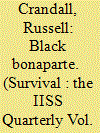

|
|
|
|
|
| Summary/Abstract |
The revolt of African slaves that erupted in Saint-Domingue in late August 1791 occurred in France’s most lucrative New World colony. Encompassing the western third of Hispaniola Island since 1659 and representing the most ‘profitable stretch of real estate on the planet’ according to historian Edward Baptist, the colony’s sugar, coffee, indigo and cotton served as the fuel for France’s ‘imperial engine’.1 Now, its sugar plantations were ablaze as slaves torched cane fields and killed their masters. With France’s own revolution having begun in 1789, free people of colour in Saint-Domingue also took up arms after French landowners refused to extend citizenship to them as laid out in the Declaration of the Rights of Man and of the Citizen. An independent Republic of Haiti was eventually established on 1 January 1804; by then, upwards of 350,000 Haitians and 50,000 French troops had been killed (the troops mostly from yellow fever), and the island nation’s economy lay in tatters.2
|
|
|
|
|
|
|
|
|
|
|
|
|
|
|
|
| 7 |
ID:
186335
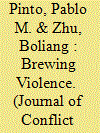

|
|
|
|
|
| Summary/Abstract |
Two prominent features in current world affairs are the unprecedented level of global economic integration and the growing incidence of intrastate violence. We develop and test a novel argument linking global integration through foreign investment to intrastate armed conflict. The presence of multinational corporations in developing countries can cause market concentration, resulting in high rents. Disputes between governments and would-be challengers over the appropriation of these rents are likely to turn violent, increasing the incidence of armed conflict. State capacity mitigates this positive association between foreign investment and intrastate war. Strong states have the capacity to deter rebellions, address citizens’ demands through institutionalized mechanisms, and credibly commit to the peaceful resolution of conflicts. Using data from developing countries for over four decades and addressing potential endogeneity and selection biases, we find strong support for our hypotheses. Our findings have important implications for understanding the link between economic interdependence and conflict.
|
|
|
|
|
|
|
|
|
|
|
|
|
|
|
|
| 8 |
ID:
152917
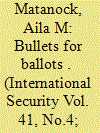

|
|
|
|
|
| Summary/Abstract |
Why does fighting recur following some civil conflict peace settlements, but not others? What kind of agreements are associated with more enduring peace? Post-conflict elections can often complicate and even undermine peace agreements. Agreements that contain “electoral participation provisions,” however, may help stabilize settlements and produce more enduring peace. Electoral participation provisions mandate that rebel groups be allowed to compete alongside the government in post-conflict elections. Such provisions encourage external actors, such as intergovernmental organizations and foreign donors, to become engaged in post-conflict elections. As part of this engagement, they can provide incentives to the parties to adhere to the terms of the settlement, as well as detect and sanction instances of noncompliance. New cross-national data suggest that conflict after peace settlements recurs less often when electoral participation provisions are included than when they are not. The data also suggest that this pacifying relationship holds when combatants expect international engagement.
|
|
|
|
|
|
|
|
|
|
|
|
|
|
|
|
| 9 |
ID:
115479
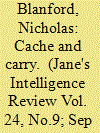

|
|
|
| 10 |
ID:
193110
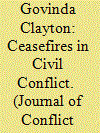

|
|
|
|
|
| Summary/Abstract |
Ceasefires are arrangements through which conflict parties commit to stop fighting. They are a common part of intra-state conflict. Existing research on intra-state ceasefires is largely limited to case studies and guidance notes for the policy and practice community. What has to date been lacking is a complementing body of comparative quantitative analysis to identify broader ceasefire trends and test the wider applicability of theory. Recent advancements in ceasefire data offer new opportunities to broaden the research agenda on ceasefires. This special section sets out the current state of the art in ceasefire research and provides the intellectual foundations to advance a new sub-field of quantitative ceasefire research. We discuss the conceptual challenges facing the study of ceasefires, offer a brief overview of ceasefire research focusing on the functions, timing, and sustainability of arrangements, and discuss the collective contributions of the articles included within this special section, and the implications for research and practice.
|
|
|
|
|
|
|
|
|
|
|
|
|
|
|
|
| 11 |
ID:
088357
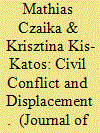

|
|
|
|
|
| Publication |
2009.
|
| Summary/Abstract |
The purpose of this article is to identify the determinants of displacement behavior based on various push and pull factors at the village level. The study concentrates on changes in village population during three years of civil conflict (1999-2002) in Aceh, Indonesia. The empirical analysis is based on a unique dataset from two census rounds of the Indonesian Village Potential Census (PODES). It uses data on around 5,200 Acehnese villages and relates village-level population change to conflict variables, geographic patterns, and traditional socio-economic determinants of migration. By applying quantile regressions, the push (outflow) factors and the pull (inflow) determinants of migration can also be distinguished. The authors identify the following factors as the main determinants of the Aceh migration pattern in this period. First, conflict clashes induced large rearrangements of the population between villages in highly affected districts, as well as strong village emigration from the geographically remote regions in Central Aceh towards the less conflict-affected coastal industrial areas. Besides conflict factors, an (ongoing) rural-urban migration process, driven by socio-economic factors, has taken place during the conflict period. Second, there is also evidence that security considerations, such as the presence of police in a village or neighborhood, were either emigration-reducing or immigration-inducing. Third, although the presence of ethnic Javanese has not been a primary cause of conflict incidence, their intimidation by the rebel movement has led to a significant outflow, primarily from conflict-affected villages in Central Aceh. These results reveal that, beside a conflict-induced fear of violence, population movements in Aceh have also been an outcome of traditional migration determinants.
|
|
|
|
|
|
|
|
|
|
|
|
|
|
|
|
| 12 |
ID:
109913
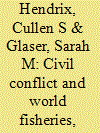

|
|
|
|
|
| Publication |
2011.
|
| Summary/Abstract |
While the negative economic consequences of civil conflict are well known, does civil conflict have sector-specific effects that threaten food and economic security? This article surveys the effects of civil conflict on reported marine and inland fish catch, focusing on the effects of conflict through redeployment of labor, population displacement, counter-insurgency strategy and tactics, and third-party encroachment into territorial waters. Analysis of 123 countries from 1952 to 2004 demonstrates a strong, statistically robust and negative relationship between civil conflict and fisheries, with civil wars (1000+ battle deaths) depressing catch by over 16% relative to prewar levels. The magnitude of this effect is large: the cumulative contraction in total fish catch associated with civil war onset is roughly 13 times larger than the estimated effect of an extraordinarily strong El Niño, the ocean-atmosphere phenomenon associated with global declines in fisheries. Robust evidence of a Phoenix effect is lacking: post-conflict fisheries do not quickly bounce back to prewar catch levels due to more rapid growth. Analysis of conflict episodes indicates that conflict intensity, measured by battle deaths, negatively affects fish catch, while population displacement and conflict proximity to the coast do not. While these findings contribute to the growing literature on the economic effects of civil conflict, they also are important for regional fisheries management organizations, which must increasingly pay attention to sociopolitical factors that dramatically affect the utilization of aquatic resources.
|
|
|
|
|
|
|
|
|
|
|
|
|
|
|
|
| 13 |
ID:
124519
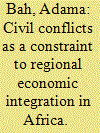

|
|
|
|
|
| Publication |
2013.
|
| Summary/Abstract |
Regional economic integration is crucial for African countries, notably since they are characterized by small domestic markets. In this paper, we analyze how civil conflicts affect the economic fate of regional economic communities through its effect on the synchronicity of regional partners' economies. We find that conflict decreases business cycle synchronicity when it occurs within a regional economic community, both for the directly affected countries and for their more peaceful regional peers. We therefore find an additional reason to recommend putting prevention and resolution of civil conflicts on the top of the political agenda of African RECs.
|
|
|
|
|
|
|
|
|
|
|
|
|
|
|
|
| 14 |
ID:
104599
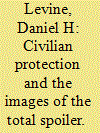

|
|
|
| 15 |
ID:
170012
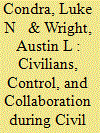

|
|
|
|
|
| Summary/Abstract |
What affects civilian collaboration with armed actors during civil war? While theory and evidence confirm that harm by armed actors influences when and with whom civilians collaborate, we argue that collaboration is also a function of civilians’ perceptions of armed actors’ efforts to minimize collateral casualties. We test this argument using a series of nationwide surveys of Afghan civilians conducted quarterly between 2013 and 2015. Our data record civilian willingness to report roadside bombs to government authorities and perceptions of government and Taliban efforts to minimize civilian harm. Civilians are less (more) willing to collaborate with the government when they perceive the government (Taliban) carelessly using force, even after accounting for political sentiment, local security conditions, and a range of additional confounding factors. Moreover, our evidence suggests that perceived carelessness in the rival’s area of control influences collaboration. We discuss how these empirical results inform broader literatures on collaboration, conquest, occupation, and control.
|
|
|
|
|
|
|
|
|
|
|
|
|
|
|
|
| 16 |
ID:
110809
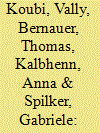

|
|
|
|
|
| Publication |
2012.
|
| Summary/Abstract |
Despite many claims by high-ranking policymakers and some scientists that climate change breeds violent conflict, the existing empirical literature has so far not been able to identify a systematic, causal relationship of this kind. This may either reflect de facto absence of such a relationship, or it may be the consequence of theoretical and methodological limitations of existing work. In this article we revisit the climate-conflict hypothesis along two lines. First, we concentrate on indirect effects of climatic conditions on conflict, whereas most of the existing literature focuses on direct effects. Specifically, we examine the causal pathway linking climatic conditions to economic growth and to armed conflict, and argue that the growth-conflict part of this pathway is contingent on the political system. Second, we employ a measure of climatic variability that has advantages over those used in the existing literature because it can presumably take into account the adaptation of production to persistent climatic changes. For the empirical analysis we use a global dataset for 1980-2004 and design the testing strategy tightly in line with our theory. Our empirical analysis does not produce evidence for the claim that climate variability affects economic growth. However, we find some, albeit weak, support for the hypothesis that non-democratic countries are more likely to experience civil conflict when economic conditions deteriorate.
|
|
|
|
|
|
|
|
|
|
|
|
|
|
|
|
| 17 |
ID:
182544
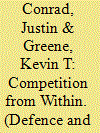

|
|
|
|
|
| Summary/Abstract |
Why do militant groups turn on each other? This behavior is somewhat puzzling, since such groups are often on the same side of a conflict. A growing body of literature seeks to understand political violence by looking at cooperative and competitive relationships among non-state actors. Debates continue about the sources of militant group rivalry. We argue that shared motivations, especially ethnic motivations, along with power differences among groups should help explain inter-group fighting. Our analysis uses new dyadic data on rivalry among the militant groups of Africa and Asia since 1990. Unlike some previous studies, we analyze both terrorist and insurgent organizations. Results suggest that pairs of groups with a shared ethnic identity are more likely than others to have rivalrous relationships. Power asymmetry is also somewhat associated with rivalry, but interaction models indicate that the association is only statistically significant in the presence of shared ethnic motivations.
|
|
|
|
|
|
|
|
|
|
|
|
|
|
|
|
| 18 |
ID:
158844
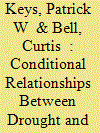

|
|
|
|
|
| Summary/Abstract |
Much of the literature on climate change adaptation claims the destabilizing consequences of environmental crises are mitigated by sociopolitical conditions that influence a state's susceptibility to scarcity-induced violence. However, few cross-national studies provide evidence of conditional scarcity-conflict relationships. This analysis of drought severity and civil conflict onset in sub-Saharan Africa (1962–2006) uncovers three sociopolitical conditions that influence the link between environmental scarcity and civil conflict: social vulnerability, state capacity, and unequal distribution of resources. Surprisingly, we find drought does not exacerbate the high risk of conflict in the vulnerable, incapable, and unequal states thought to be especially susceptible to increased scarcity. Instead, drought negates the peace-favoring attributes of stable states with less vulnerable populations. During severe drought, states with sociopolitical conditions that would otherwise favor peace are no less likely to suffer conflict than states with sociopolitical conditions that would otherwise increase the risk of violence. These findings, which are robust across several measures of these sociopolitical concepts, suggest environmental scarcity is most likely to increase the risk of conflict where populations have more to lose relative to periods with more favorable weather.
|
|
|
|
|
|
|
|
|
|
|
|
|
|
|
|
| 19 |
ID:
142038
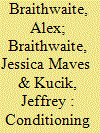

|
|
|
|
|
| Summary/Abstract |
Violent domestic conflicts spread between countries via spillover effects and the desire to emulate events abroad. Herein, we extend this emulation logic to the potential for the contagion of nonviolent conflicts. The spread of predominantly nonviolent pro-democracy mobilizations across the globe in the mid-to-late 1980s, the wave of protests in former Soviet states during the Color revolutions in the 2000s, and the eruption of nonviolent movements across the Middle East and North Africa during the Arab Spring in the early 2010s each suggest that the observation of collective action abroad encourages a desire to emulate among potential challengers to domestic autocrats. However, the need to emulate varies. Potential challengers with a recent history of protest at home are less dependent (than are those without similar experience) upon foreign exemplars to mobilize the participants and generate the resources required to make emulation practicable. By contrast, where the domestic experience of protest is absent, opposition movements are more reliant upon emulation of foreign exemplars. We test the implications of this logic using a series of multivariate logistic regression analyses. Our tests employ data on nonviolent civil resistance mobilizations that occurred across the global population of autocratic states between 1946 and 2006. These tests, along with post-estimation analysis, provide evidence consistent with our conditional logic of emulation.
|
|
|
|
|
|
|
|
|
|
|
|
|
|
|
|
| 20 |
ID:
139408
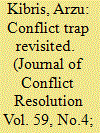

|
|
|
|
|
| Summary/Abstract |
This article analyzes the association between civil conflicts and educational achievement by studying the Turkish case. It combines the 2005 university entrance exam scores of more than 1.6 million students and a newly constructed data set on the casualties of the Turkish–Kurdish conflict to study the association between the conflict and educational achievement of Turkish students. The results reveal a significant negative association. Combined with the already well-established positive links between education and various measures of socioeconomic development like economic growth, social equality, and public health, the results in this article demonstrate that education is one of the channels through which civil conflicts damage the well-being of societies thereby creating the conditions that perpetuate them.
|
|
|
|
|
|
|
|
|
|
|
|
|
|
|
|
|
|
|
|
|